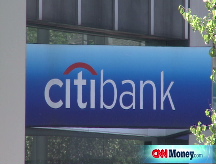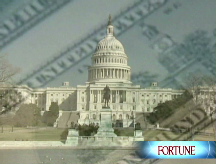Bond prices rally as GDP slows
Investors weigh the worst economic slowdown in 26 years with continued debate about how to rescue the banking sector.
NEW YORK (CNNMoney.com) -- Treasury prices rose Friday after a report showed the nation's economy shrunk in the fourth quarter and economists debated how to rescue the banking system.
"We stopped the hemorrhaging in bond prices that had occurred in the previous number of days," said Mary Ann Hurley, a vice president of fixed income trading at D.A. Davidson.
The government debt market has largely been shrugging off negative economic news - which typically creates demand for the safe haven of Treasurys and pushes prices higher. Instead, Treasurys prices have been trending lower since the start of the year as the market digests a record amount of debt being auctioned.
The 30-year bond, for example, has fallen about 25 points since December and the yield, which rises when prices drop, had climbed more than a full percentage point. Friday, however, the 30-year longbond rallied 12/32 to 116-15/32 and its yield fell to 3.59%. Bond prices and yields move in opposite directions.
The 10-year benchmark Treasury rose 9/32 to 107-27/32 and its yield fell to 2.83%. The 2-year note edged up 2/32 to 99-29/32 and its yield dipped to 0.94%.
The yield on the 3-month note, meanwhile, was 0.24%. The 3-month bill has been used as a short-term gauge of confidence in the marketplace, because investors tend to shuffle funds in and out of the bill as they assess risk in other places - the lower the yield, the more risk they see.
The government reported Friday that the economy's broadest measure of growth, gross domestic product (GDP), fell at an annual rate of 3.8% in the fourth quarter, the biggest quarterly slowdown in 26 years. That's the largest drop in GDP since the first quarter of 1982.
Still, GDP decline was less than the 5.5% drop predicted by economists surveyed by Briefing.com. "The number wasn't as bad as expected, but it was the worst number since 1982 so it was still a horrible number," said Hurley.
Hurley also added that a big reason that the GDP reading was not as bad as expected was because inventories jumped up in the quarter. When businesses create goods - even if those goods go into storage and consumers do not purchase them - it adds to GDP. "Given the slow global demand, it seems highly unlikely that businesses are going to add to inventories going forward," she said.
Investors have also grown increasingly concerned about the health of the already beleaguered banking sector. The Obama administration has been debating the best way to support the banking industry, and while the debate continues, there is one point of consensus - it will be very costly.
The House passed a $819 billion stimulus plan Wednesday night and the recovery plan will be taken up by the Senate next week. With the deficit already expected to top $1 trillion in 2009, the expectation that the banking sector will require more help kept downward pressure on gains in Treasury prices. To fund the rescue, the government will have to sell Treasurys, and a flood of supply pushes debt prices lower.
The Treasury auctioned $135 billion worth of debt this week, following a $120 billion sale last week. On Thursday, a record $30 billion worth of 5-year notes were offered and, on Tuesday, the government auctioned a record $40 billion worth of 2-year notes.
Lending rates: The 3-month Libor rate edged very slightly higher to 1.18% from 1.17% Thursday, according to data available at Bloomberg.com. The overnight Libor rate surged to 0.30% Friday from 0.22%.
Libor, the London Interbank Offered Rate, is a daily average of rates that 16 different banks charge each other to lend money in London, and it is used to calculate adjustable-rate mortgages. More than $350 billion in assets are tied to Libor.
Two credit market gauges were mostly unchanged. The so-called "TED" spread was unchanged from the day before at 0.94 percentage points. The bigger the TED spread, the less willing investors are to take risks. The rate surged as the credit crisis gripped the economy, but it has since fallen off as central banks around the world have lowered interest rates and pumped liquidity into the economy.
Another market indicator, the Libor-OIS spread, edged down slightly to 0.94 percentage point from 0.95 percentage point the day before. The Libor-OIS spread measures how much cash is available for lending between banks and is used for determining lending rates. The bigger the spread, the less cash is available for lending.
Talkback: Get your economic questions answered. E-mail realstories@cnnmoney.com with questions about jobs, housing, energy, student loans, credit cards, Americans' spending and savings habits, etc., and they could be answered on air as part of the first CNN Money Summit. ![]()




